#pagination css html
Explore tagged Tumblr posts
Note
hi!!! i love for custom blog theme,, do you have a link to the code or creator 0:?
ya!
so my theme is actually a heavily modified version of redux edit #1 by lopezhummel (current url: holyaura). i always remind users that most tumblr themes are old and that you'll need to replace all instances of "http://" in the code with "https://" so tumblr will save the theme. i had to do it with this one
these are the modifications i made to the theme. i edited this theme over the course of at least a year or so and don't quite recall how i did all of these things. but to the best of my ability:
i moved the "left side img" to the right side of the screen. i also made this element "responsive" so the image will never get cropped when you resize your screen. this was a bitch and a half to figure out and i truthfully do not remember how i did it
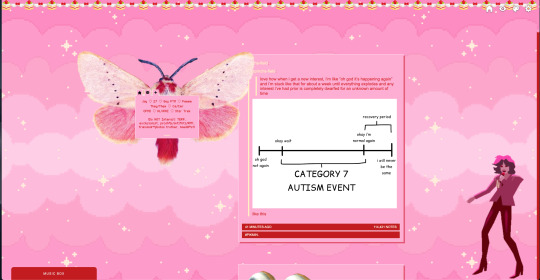
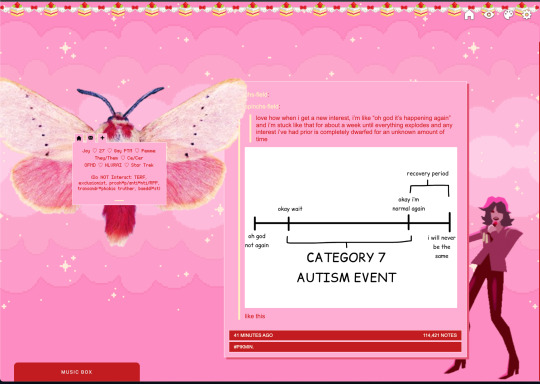
i deleted the text in the drop-down navigation so it appears as a little line that is otherwise not noticeable. this type of theme, the "redux edit," used to be very popular because having a drop-down menu let you cram a bunch of links that lead to sub-pages on your blog. i've done away with my sub-pages, but i still like the format of the "redux style" tumblr theme, for its minimal UI and for its customization options.
i separated my mobile description from my web description for formatting reasons. basically, most elements in tumblr themes are connected to specific text fields and toggles. i simply went to the section that was connected to my blog description and deleted it. the web description has to be manually typed inside of the CSS/HTML editor when i want to change it. whereas my mobile description is whatever i type in the "description" box of the normal tumblr theme editors.


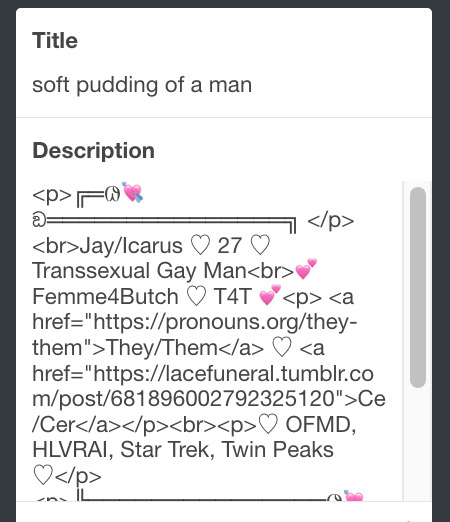

i added code someone else made ("NoPo" by drannex42 on GitHub) which allows you to hide posts with certain tags on them. i did this to hide my pinned post, as it looks bad on desktop.
i replaced the tiny pagination arrows at the bottom with images that literally say "next" and "back" because the arrows were far too small/illegible. i know they aren't centered in the container i'm not sure how to fix that lol

i added a cursor

i installed a working music box ("music player #3" by glenthemes), and then added music by uploading MP3 files to discord and then using the links of those files as the audio sources. iirc i also had to make this element responsive and i aligned it so it would sit on the left side of my screen. i made the "album art" for each one the same strawberry pixel art
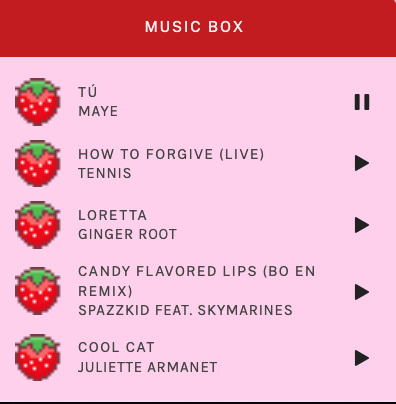
the moth is just a PNG i added and then moved around so it was behind my sidebar using the options that came pre-packaged with the theme
if you want something like the strawberry shortcake decoration at the top (called "banner" in the theme) your best bet is to google "pixel divider"
theme didn't support favicon so i added that in so i could have a little heart

ALSO:
this theme is. really weird about backgrounds. any background that i have ever set for it, i've had to do weird shit in photoshop. like making the background HUGE, mirroring it, etc. - because it would crop the image weird, or there would be a gap where there was no image. idk man, it's haunted. i'm sure there's a way to fix this but i am NOT tech savvy enough. anyway, patterns are probably your best friend. and if you DO want something that isn't a pattern, it's going to take a lot of trial and error. but i love this theme so i deal with it 😭
the sidebar image and the floating image do not scale. if your image is 1000 pixels, it will display at 1000 pixels. you'll either have to edit the code so that the theme scales the image for you, or resize any images before you add them
my white whale of theme editing (aside from the Weird Background thing) is that i cannot get infinite scrolling to work. i have tried every code out there. all of them break my theme. it makes me sad because like. i have music there for a reason. the idea is that people would listen to it while they scroll. unfortunately, the way it's set up now, the music will stop every time someone clicks "next" or "back" 💀
anyway sorry for rambling but i hope you enjoy the the theme and customizing it in the way that you want to!
23 notes
·
View notes
Text
Piovrandom 3.0!

1. Piovrandom ha 16 anni e ho deciso di creare una terza veste. L’ultima realizzata era ormai datata nel 2015, ai suoi 7 anni.
2. Doppia colonna per la versione desktop, monocolonna per i dispositivi mobili (>1024px), con menu a comparsa da sinistra.
3. La 3.0 l’ho battezzata come “Nuntemollo” perché era doveroso e necessario un intervento serio sia di abbellimento che di ordine, oltre che di pulizia. Tra le altre cose, recentemente sono apparsi problemi con i post sincronizzati con Instagram, da cui venivano condivise le foto e diciamo chiaramente che era "l'alimentatore" principale in questo lido. Purtroppo però, non per colpa mia, non è più possibile il sincronismo automatico e gli embed manuali risultano orripilanti per la grafica: in sostanza non è più possibile condividere la sola immagine, bensì l'intera porzione del post su ig che comprende anche il nickname con sfondo bianco: soluzione orripilante per la veste di questo sito. In termini tecnici, il post viene inserito come se fosse un iframe che include tutto il contenuto. Per quanto mi riguarda, tutto ciò comporterà che le prossime foto verranno pubblicate manualmente. Una bella seccatura, ma non posso fare diversamente. Ultimamente le politiche di Zuckerberg mi stanno allontanando spontaneamente da Instagram poiché ormai è tutto incentrato sui reels e sulle produzioni video. In sostanza, è diventato un secondo Tik Tok e ciò è il motivo per cui ho condiviso mooolto meno anche qui. Tumblr, dopotutto, è rappresentato il mio terzo lido per quanto concerne la blogosfera: la mia storia sulla blogsfera, difatti, è sintetizzabile con l’esordio su Splinder nel 2002/03, poi MSN Spaces (12/2024) infine WordPress. Tumblr è nato a cavallo tra gli MSN Spaces e Wordpress nel 2006 ed oggi è l'unico blog rimasto in vita dopo aver mandato Piovrablog in pensione due anni fa.
4. I Tumblr sono l’unico luogo dove sento così vicino il ricordo degli MSN Spaces, per quello che hanno rappresentato nella vita del sottoscritto. La soddisfazione di tirare su un proprio spazio graficamente, con solo codice HTML/CSS/JS è un qualcosa di indescrivibile. Cerco sempre di realizzare le cose come meglio dovrebbero rappresentarmi e ciò vale anche per questo luogo.
5. Elenco dunque le cose su cui ho lavorato principalmente:
Fix alla struttura mobile che aveva diversi bug, alcuni dei quali da impazzirci solo per individuarli. Ho anche fixato lo sfondo che ora rimane fisso;
Riordinato le info post spostando tutto sotto ogni post. In sede ho aggiunto anche i pulsanti di condivisione: Facebook, Whatsapp, X, Pinterest, Telegram e mail;
Aggiunti effetti ai bordi (ben visibili su desktop) e gli effetti slide alle due colonne.
Sistemate le immagini e i video adattandoli ad ogni schermata. Ho cercato quanto più possibile di ordinare la visualizzazione di un set di foto;
Aggiunte pagina "privacy policy" e "disclaimer", ricordando a tutti questo tumblr è monitorato da tempo da Google Analytics e che i dati prelevati sono in formato anonimo;
Sistemate le pagine di ricerca e tag;
Tornata visibile la lista dei like e reblog sotto ogni post. I pulsanti stessi di interazione per la Community sono stati spostati sulla sinistra.
Sembrano poche cose, ma in realtà mi hanno portato via diverse ore che ho sfruttato nel mio tempo libero. E' da Gennaio che ho iniziato a rimettere mani sul codice. Così, tanto per farvi capire. Conclusioni. Anche se ormai i social hanno letteralmente divorato il pubblico delle nostre blogsfere, non smetterò mai di ringraziare gli ormai pochissimi sopravvissuti che mi leggono e soprattutto tutti coloro che come il sottoscritto continuano ostinatamente a produrre contenuti alla vecchia maniera, che poi alla fine sono il modo migliore per descrivere i nostri mondi, più di qualunque altra cosa, immagini filtrate e ben selezionate comprese.
Grazie a tutti. ❤️
2 notes
·
View notes
Text
Coming from a complete coding noob:
Anybody got a way to explain programming pagination and "Galleries" (for both images and literature) onto Neocities/specific Neocities pages? With galleries, I'm trying to aim for small thumbnails that can be clicked on to show the full-size image (with-or-without a text description), and for pagination I want something with 10 pieces per page.
I know a small amount about HTML, and very little about CSS and JavaScript (even when looking through various tutorials), and when I try looking things up about incorporating either of them on their own and I can never get a straight answer, or the answer requires external programs, or they end up explicitly contradicting each other.
Any assistance, tips, or hints?
Thank you in advance! 👋
3 notes
·
View notes
Text
ID. first screenshot is white and lavender text on a black background and reads:
ayano's neocities comment widget!
i created a neocities-friendly comment system! i love static web hosting, and i love neocities, but i've always found it frustrating that the only options to include a comment section on my websites were usually either not very customizable, redirected to external pages, or even costed money to remove ads and get all the features. this comment widget is my solution. you can see a working example of it at the bottom of the page! the example shown uses the standard dark theme. feel free to leave a comment with it! (but please don't spam or overuse profanity!)
features:
easy to use - just download the .js file and the .css file, do the initial setup only once, then paste two lines of HTML on any page you want a comment section on!
automatic comment sections - new comment sections are automatically placed on new pages based on file path without any extra effort
fully customizable with no javascript knowledge - all parts of the widget have clearly documented IDs and class names so they can be fully edited through CSS without touching the javascript
user replies - users are able to reply to pre-existing comments! there's an option to collapse the replies with a "show replies" button, too
pagination - when the number of comments exceeds the max amount of comments chosen by the webmaster, buttons to toggle through pages are automatically generated
word filtering - includes a simple word filter to block profanity or other undesired words from appearing on the page in both names and the contents of the comment, able to be freely edited by the webmaster
other various settings - easily change character limits, timestamp format, and more
free & requires no credit - my code is 100% free and able to be changed as much as desired and without any credit on the page! i don't mind! (but feel free to leave credit if you want to!)
the other images are test comments in the dark style and in a pink style. End ID.
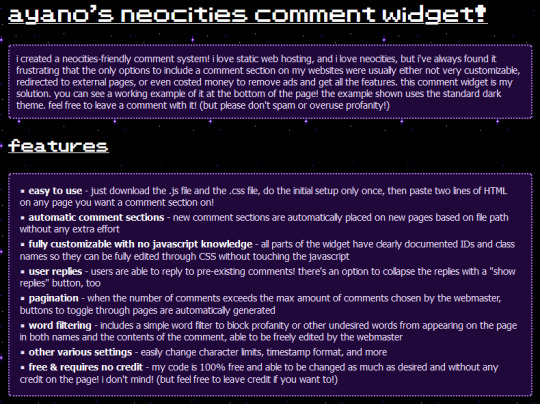
i made a free to use, 100% customizable comment widget for neocities users! it's really easy to install and add comment sections to any page. no more boring cbox or external guestbooks if you don't want them! and it comes with two themes to get you started!! please enjoy! you can find it here on my personal site!
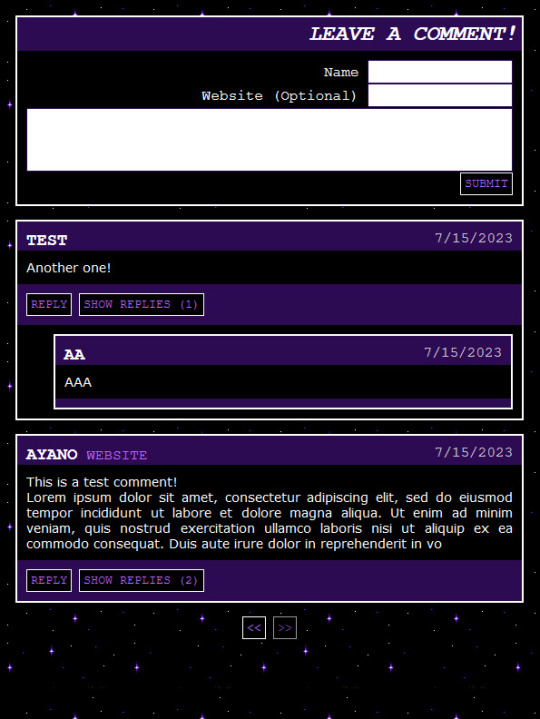
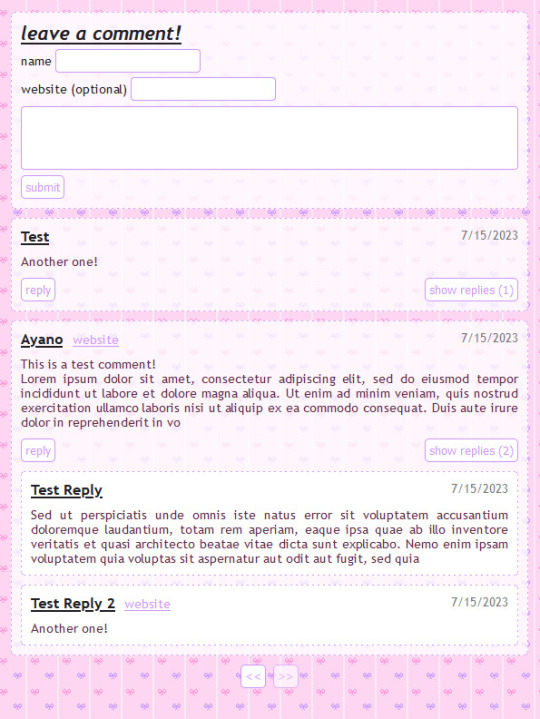
6K notes
·
View notes
Text
como criar um theme do #ZERO
Bom vou ensinar como fazer um theme do 0 bom... a plataforma do tumblr usa HTML E CSS entao nosso codigo base vao ser eles...
Primeiro abra seu bloco de notas ou o app dum blog secundario ou algo que de para fazer seu theme ... e cole os seguintes codigos:
<html> <head> <title>{Title}</title> <style> </style> </head> <body> </body> </html>
dentro de <style> </style> fica o css do theme essa é a parte onde voce cria efeitos e define o 'estilo' do seu theme (cores, fontes ,tamanho das caixas de posts...)
entre <body> e </body> fica o 'corpo' que é onde fica as tags de posts...
vamos começar a personalizar nosso theme ...
no css tu coloca esse codigo:
/***BODY*********************/ body{ background-attachment:fixed; background-color:#c5c5c5; background-image: url('URL DO SEU BG'); font: 11px 'verdana';color:#000000;}
esse codigo define a cor do fundo (background-color:#c5c5c5;) O o tamanho da fonte ,cor, e qual ela vai ser (font: 11px 'verdana';) e esse
a{color: #000000 ; text-decoration: none;}a:hover{ color:#1f1f1f;}a img{border:0}
define a cor dos links ...
posts e sidebar
A sidebar é a parte onde a descriçao , foto , menu .... fica é aquela caixa que tem ao lado dos posts ....
#sidebar {width:225px; margin-left:250px; height:auto px; margin-top:10px; position:fixed; overflow:hidden; background-color: #f6f6f6; padding:01px;}
o width:225px define a largura da caixa , voce pode variar o tamanho pra qual numero tu quiser, o margin-left:250px define a distancia da esquerda e o height define o comprimento ....
Posts
/*******POSTS********************/ #conteudo {width:550px; float: left;padding-bottom: 5px;margin-left:530px;} .posts{float: left;width: 502px;padding: 03px;overflow: hidden; background: #fff;margin:3px;text-align:justify;}
a primeira div #conteudo define a largura do lugar onde vai ser os posts e a distancia da esquerda (margin left)
e a segunda define a largura dos posts a cor do fundo a margem e aquele (overflow: hidden ) vai fazer com que as coisas nao 'saiam' da caixa dos posts ...
Titulo dos posts
/***TITULO POSTS***/ #h1{font-family: 'verdana', sans-serif;color:#000000; font-size:19px;}
Bom essa div vai definir o titulo dos posts o font-family vai definir qual fonte vai ser , color:#0000000 é a cor da letra e fo font-size define o tamanho da letra .
Descriçao
/***DESCRIÇAO**************/ #description {font-family: 'verdana', sans-serif; font-size:09px; text-align:center; margin-bottom: 2px; color:#000;}
essa div vai definir o estilo da descriçao bom basicamente é a mesma coisa do titulo dos posts ....
imagem da sidebar
#sidebarimg img {max-width:243px; height: auto;}
essa div é muito simples ela só define o tamanho da imagem da sidebar...
Paginaçao
bom aqui vamos usar a paginaçao de setas '>><<'
/***PAGINAÇAO**************/ #pagination {font-size:30px; text-align: center; font-family:'Electrolize'; text-align:center;} #pagination a{color:#000000}
'fonte size' tamanho da fonte ; text-align: center; texto no centro (pode variar pra left ou right)...
Esse vai ser nosso css base, agora falta montar o 'corpo' do theme ....
basicamente tu vai precisar da tags de post que tu encontra aqui
mas como sou uma boa pessoa vou passar ela ja pronto basta clicar aqui copiar o codigo e colar abaixo de <body> ...... com o tempo tu vai aprendendo a montar teus proprios codigos ,tuas divs, efeitos hover e tals.... com a nossa base ficou assim :
codigo da base
acho que ficou bem explicado talvez meio confuso mas enfim ... tuto por bail nao copie se usar a base credite ok?ok
0 notes
Text
Are you looking to learn and search for the best Backbone js book that can help you learn Backbone js programming in the most effective way? Backbone.js is fundamentally a JavaScript library which is based on MVP or model–view–presenter. One of the great positives of Backbone is that it’s lightweight and is extremely efficient for building single-page web applications, also for synchronizing various web application parts. Backbone.js is also known as CoffeeScript. This article will talk about some must-read Backbone books and help you make an informed choice of the book that suits your requirements. Highly Recommended Books on Backbone.js For Beginners Developing Backbone.js Applications Kindle Edition (By: Addy Osmani ) Developing Backbone.js Applications – Kindle Version This is one of the best Backbone books available in the market. This book is regarded as a one-stop-shop for Backbone js. It contains an introduction about the Backbone js along with chapter that includes basic of Backbone js with couple of solid Backbone.js examples. This is just a start. As you move on reading the book, it will reveal the other contents including Backbone.js extensions like Paginator, Thorax, Marionette and others. It also contains some JavaScript libraries like SinonJS, QUnit, Jasmine, jQuery Mobile and RequireJS. Backbone.js Patterns and Best Practices Kindle Edition (By: Swarnendu De ) This Backbone js book renders an overview of some of the useful concepts and techniques of Backbone.js. The book contains some examples of typical patterns, concepts, usages of each of the main pieces of Backbone that include Collections, Models, Views Events/Storage and Routers. The writing style of the book is such that it will give you a feel that you are sitting in a classroom and studying Backbone.js. The book also contains chapters on usage of AMD with the required .js files. Backbone.js Essentials Kindle Edition (By: Jeremy Walker ) This book is an essential medium to learn the tools that will teach you how to construct top-notch web applications by mastering and using powerful tools provided by Backbone.js. If you are a developer having proficiency in baseline JavaScript and have familiarity with jQuery library, this book is just perfect for you. This Backbone book will help you learn architecting a single-page web application using the basic tools of Backbone.js and also explore advanced Backbone techniques in order to save time and effort using the available powerful third-party tools. Backbone.js Blueprints Kindle Edition (By: Andrew Burgess ) If you want to learn building front-end applications using Backbone.js, this book is perfect. The book contains easy-to-follow examples that will take the reader through building seven different web applications using Backbone.js. However, it is mandatory for you to thoroughly familiarize yourself with working knowledge of CSS and HTML. You can start by creating a small blog with Backbone Express and gradually start learning the basics for reading as well as writing data with a REST API. Beginning Backbone.js (Expert's Voice in Web Development) Kindle Edition (By: James Sugrue ) This book is a step-by-step guide when you want to learn and use Backbone.js library in web projects. This book will help you learn the importance of MVC approaches when you are developing a software. The great collection of examples and to-do logics help you understand the way of integrating Backbone.js into the JavaScript stack. The book starts with basic like understanding the core Backbone.js concepts such as events, routers, models and views. If you are confident with JavaScript, this book is excellent for you. Backbone.js Testing Kindle Edition (By: Ryan Roemer ) The book brings challenges to the current techniques along with sensible practices in Backbone.js test development. The book is a great repository of fundamental testing concepts along with practical exercises and comprehensive test infrastructure designs.
In the middle chapters you can find APIs and usage of three important testing tools, this include Chai – an assertion library, Mocha – a test runner and Sinon.JS – a library for test doubles. The best part of the book is that it does not get deviated and it sticks to its true meaning of its name. Pro Single Page Application Development: Using Backbone.js and ASP.NET Kindle Edition (By: Gil Fink, Ido Flatow ) This is book is the best book to learn how to master single page application or SPA development along with key concepts of SPA architecture. This book will help you understand and master JavaScript development techniques and also introduce you to the popular Backbone.js library, also its usage in developing a SPA. You will learn to create backend using ASP.NET and also test run and measure the performance of your SPA. Moreover, you can overcome difficulties that you may encounter with SPA, in case of Search Engine Optimization or SEO. You now have information about a few excellent books on Backbone.js that can help you get a comprehensive understanding of Backbone.js. These books will help you understand the most basic Backbone js logic in the beginning and gradually move on to advanced levels of learning. You can make use of this article to choose the best book for you and start developing your applications. With these books, you will surely enhance your knowledge and apply the learnt concepts in your Backbone.js application development.
0 notes
Text
How to Optimize Crawlability and Indexing for Classified Ads Sites

Running a classified ads site can be a rewarding venture, but ensuring your site ranks well on search engines requires optimizing its crawlability and indexing. Without this foundation, even the most well-designed site might struggle to attract organic traffic. In this guide, we’ll explore proven strategies and techniques to make your classified ads site more search engine-friendly.
Understanding Crawlability and Indexing
What is Crawlability?
Crawlability refers to how easily search engine bots can navigate and discover your site’s content. If bots face roadblocks, they might not index your site’s important pages.
What is Indexing?
Indexing is the process where search engines store and organize the content they’ve crawled. Proper indexing ensures that your pages appear in relevant search results.
Importance of Optimizing Crawlability and Indexing
For classified ads sites, which often have a large volume of frequently changing content, ensuring crawlability and indexing is critical. Without optimization, search engines might overlook new listings or fail to de-index expired ones. This can lead to poor user experience and reduced visibility.
Steps to Optimize Crawlability
1. Use a Clear Site Structure
A well-organized taxonomy improves navigation for both users and search engines.
Best Practices for Site Structure:
Use categories and subcategories to group similar ads.
Create an intuitive hierarchy (e.g., Home > Vehicles > Cars).
Avoid orphan pages by linking every page to at least one other page.
2. Implement a Sitemap
Sitemaps act as roadmaps for search engine bots.
XML Sitemap:
Include all essential pages, such as category pages and individual listings.
Regularly update it to reflect changes in your content.
HTML Sitemap:
Provide users with an overview of your site’s structure.
Improve internal linking opportunities.
3. Optimize Internal Linking
Internal links help distribute authority across your site and guide bots to deeper pages.
Tips for Effective Internal Linking:
Link from high-authority pages (e.g., homepage) to important categories.
Use descriptive anchor text that includes relevant keywords.
Avoid broken links by routinely auditing your site.
4. Block Irrelevant Pages with Robots.txt
Not all pages are worth indexing. Use the robots.txt file to guide bots.
Examples of Pages to Block:
Login or registration pages.
Admin panels.
Filter or sort result pages.
Strategies to Improve Indexing
5. Ensure Mobile-Friendliness
Google prioritizes mobile-first indexing, so a responsive design is essential.
How to Achieve Mobile-Friendliness:
Use a mobile-responsive theme.
Optimize images for faster loading.
Simplify navigation for small screens.
6. Address Duplicate Content
Duplicate content can confuse search engines and hurt rankings.
How to Avoid Duplicate Content:
Use canonical tags to identify the primary version of a page.
Minimize identical content across listings.
7. Regularly Update Content
Fresh content signals relevance to search engines.
Suggestions for Updates:
Encourage users to renew expired ads.
Highlight trending or featured listings.
Add a blog section with industry-related content.
8. Leverage Structured Data
Structured data helps search engines understand your content better.
Key Markups for Classified Sites:
Product schema for individual listings.
Breadcrumb schema for navigation.
Review schema for user-generated reviews.
Technical SEO for Enhanced Crawlability and Indexing
9. Optimize Page Speed
Slow-loading pages deter users and bots alike.
How to Improve Speed:
Compress images and use next-gen formats (e.g., WebP).
Enable browser caching.
Minimize JavaScript and CSS.
10. Fix Broken Links
Broken links waste crawl budget and harm user experience.
Tools to Identify Broken Links:
Google Search Console.
Screaming Frog SEO Spider.
11. Use Pagination Properly
Pagination helps organize large datasets, like hundreds of listings in a category.
Best Practices for Pagination:
Use rel=”next” and rel=”prev” tags.
Avoid endless scrolling without providing pagination.
12. Monitor Crawl Errors
Regularly check for crawl errors using tools like Google Search Console. Address issues such as 404 errors, server errors, or blocked pages promptly.
Content Optimization for Classified Sites
13. Optimize Meta Tags
Meta titles and descriptions are crucial for improving click-through rates (CTR).
Tips for Better Meta Tags:
Include keywords relevant to the category or listing.
Keep descriptions concise and compelling.
Add CTAs like “Shop Now” or “Explore More.”
14. Write Unique Listing Descriptions
Generic descriptions lead to poor SEO performance.
How to Create Unique Descriptions:
Highlight key features of the product or service.
Use varied language to describe similar items.
Incorporate local keywords for geo-targeting.
15. Include User-Generated Content
User reviews and comments add unique content to your pages.
Encourage User Engagement:
Add a review section for listings.
Implement a “Question & Answer” feature for prospective buyers.
16. Define Clear Taxonomies
Taxonomies organize your site’s content, making it easier for search engines to understand.
Example of a Taxonomy Structure:
Primary Category: Vehicles
Subcategory: Cars
Filter: Price Range
17. Use Ontologies to Connect Concepts
Ontology goes beyond taxonomy by establishing relationships between entities. For example, connect “used cars” with “affordable transportation.” This adds depth to your content.
Advanced SEO Techniques
18. Optimize for Local SEO
Classified ads often target specific regions.
Local SEO Tips:
Add location-based keywords to titles and descriptions.
Create dedicated pages for major cities or regions.
19. Implement Social Sharing Features
Encourage users to share listings on social media platforms. Social signals may indirectly influence your rankings.
20. Use a Content Delivery Network (CDN)
A CDN speeds up page load times for users in different geographical locations. This improves crawlability by reducing server response times.
Tracking and Measuring Performance
21. Monitor Key Metrics
Track metrics like crawl stats, indexed pages, and CTR using tools like:
Google Analytics.
Google Search Console.
22. Conduct Regular SEO Audits
Audits help identify weaknesses in your SEO strategy. Focus on:
Broken links.
Crawl errors.
Thin or duplicate content.
Conclusion
Optimizing crawlability and indexing for classified ads sites involves a mix of technical SEO, content enhancements, and strategic planning. By implementing these practices, you can improve search engine visibility and attract more users to your platform. To dive deeper into related strategies, Click here.
FAQs
1. How do I identify crawl errors on my site?
Use tools like Google Search Console or Screaming Frog SEO Spider to detect crawl errors such as 404 pages or server issues.
2. What is the ideal frequency for updating a sitemap?
Update your sitemap whenever you add or remove significant content, such as new categories or listings.
3. Why is mobile-friendliness important for SEO?
Google uses mobile-first indexing, which prioritizes the mobile version of your site in rankings. A mobile-friendly design ensures better visibility.
4. How does structured data benefit classified ads sites?
Structured data helps search engines interpret your content, making it eligible for rich results like product details and reviews in search snippets.
5. What are the risks of ignoring duplicate content issues?
Duplicate content can dilute your site’s authority and confuse search engines, leading to lower rankings or exclusion from search results.
0 notes
Text
How to Easily Speed Optimize Your Webflow Website
Optimizing your Webflow website for speed is essential for enhancing user experience, improving SEO rankings, and boosting conversions. Here’s a step-by-step guide to help you easily speed up your Webflow site.
1. Choose a Lightweight Design
Minimalist Approach: Start with a clean, minimalist design. Avoid overly complex layouts and excessive animations that can slow down loading times.
2. Optimize Images
Image Compression: Use tools like TinyPNG or ImageOptim to compress images before uploading them to Webflow. This reduces file sizes without compromising quality.
Responsive Images: Ensure images are responsive and scaled correctly for different devices. Webflow allows you to set different image sizes for various breakpoints.
3. Use Webflow’s Built-In Hosting Features
Leverage Fast Hosting: Webflow’s hosting is optimized for speed. Make sure you’re using their built-in features like SSL and CDN for faster content delivery.
4. Minimize Custom Code
Limit JavaScript and CSS: Avoid excessive custom code that can bloat your site. Only add necessary scripts and styles, and consider using Webflow's native functionality whenever possible.
5. Reduce Redirects
Avoid Unnecessary Redirects: Check for and minimize redirects, as they add additional loading time. Keep your URLs clean and direct.
6. Implement Lazy Loading
Load Content as Needed: Use lazy loading for images and videos, so they load only when visible on the user’s screen. This can significantly improve initial load times.
7. Optimize Fonts
Limit Font Variations: Use a limited number of web fonts and avoid using too many font weights. Consider using system fonts for better loading times.
8. Reduce the Number of Animations
Be Mindful of Animations: While animations enhance design, too many can slow down performance. Use them sparingly to maintain a balance between aesthetics and speed.
9. Utilize Clean Code
Minify HTML, CSS, and JavaScript: If you’re using custom code, ensure it’s clean and well-structured. Use tools to minify these files to reduce their size.
10. Optimize CMS Collections
Limit Items Displayed: When using CMS collections, limit the number of items displayed on each page. Use pagination or “load more” features to improve load times.
11. Monitor Performance Regularly
Test Your Site’s Speed: Regularly use tools like Google PageSpeed Insights, GTmetrix, or Pingdom to analyze your site’s speed and identify areas for improvement.
12. Utilize Webflow’s SEO Features
Optimize Metadata: Ensure your site’s metadata is properly set up. Well-optimized metadata can help with loading speed and improve SEO.
13. Consider External Resources Carefully
Limit External Scripts: Be cautious when adding third-party scripts or integrations. Each script can add loading time, so use them only when necessary.
By following these steps, you can effectively speed-optimize your Webflow website. A faster site enhances user experience, improves search engine rankings, and increases conversions. Regularly review and adjust your optimizations to maintain peak performance. To manually Optimize Your Webflow website, You Can Hire a Webflow Speed Optimization Expert.
#webflow #webflowspeed #webflowspeedoptimization #speedoptimization
0 notes
Text
The Best Table Plugins for WordPress: A Comprehensive Guide

Selecting the ideal table plugin for your WordPress site is crucial for presenting data clearly and effectively. The right plugin can enhance the readability and functionality of your site, making it more engaging for visitors. To optimize your site's navigation, consider integrating tools like the Best WordPress Menu Plugins.
Here’s a detailed look at the top options for the best table plugin for WordPress: TablePress, Ninja Tables, and WP Table Builder.
TablePress
TablePress is a favorite among WordPress users for its simplicity and powerful features. Key benefits include:
Ease of Use: No coding skills required, making it accessible for all users.
Comprehensive Features: Includes sorting, pagination, and import/export capabilities for Excel, CSV, and HTML files.
Customization: Advanced users can add custom CSS for tailored table designs.
Ninja Tables
Ninja Tables is known for its responsive design and extensive customization options. Noteworthy features are:
Responsive Design: Ensures tables look great on any device.
Customization Options: Provides various styles and customization features.
Google Sheets Integration: Real-time data updates make it ideal for dynamic content.
WP Table Builder
WP Table Builder is a drag-and-drop table builder perfect for creating complex tables with ease. Key features include:
Drag-and-Drop Interface: Intuitive and user-friendly.
Pre-Built Templates: Offers a variety of templates to get started quickly.
Versatile Elements: Supports text, images, lists, buttons, and more for diverse table content.
Choosing the best table plugin for WordPress depends on your specific needs and the features that are most important for your site.
Enhancing Your WordPress Site
Knowing how to get plugins menu in WordPress is essential for effectively managing your site’s plugins. This involves navigating to the 'Plugins' section in your dashboard to add, activate, and manage your plugins.
Advanced navigation features can significantly boost user experience. The best Mega menu plugin WordPress offers extensive customization options for creating detailed and attractive menus.
Specialized Plugins for Specific Requirements
For restaurant websites, a WordPress restaurant menu plugin can be particularly valuable. These plugins showcase menu items beautifully and often include features like online ordering and reservations.
If budget is a concern, exploring the best WordPress menu plugins free can provide robust solutions without financial investment.
In summary, the best table plugin for WordPress depends on your unique requirements. Plugins like TablePress, Ninja Tables, and WP Table Builder offer a range of features to meet various needs. Additionally, integrating relevant plugins such as the Best WordPress Menu Plugins can enhance your site's overall functionality and user experience.
1 note
·
View note
Text
Minimal Responsive Image Carousel - Classic Slider
The Classic Slider is a lightweight and responsive image carousel built using HTML, CSS, and JavaScript. It features auto-rotating, navigation arrows, pagination indicators, and a fade-in animation for slides. How to use it: 1. Add the Boxicons CSS link to your webpage. OPTIONAL. <link rel="stylesheet" href="/path/to/cdn/boxicons.min.css" /> 2. Add your images and descriptive text within the…
0 notes
Text
How Easy Is It To Scrape Google Reviews?

Have you ever wished you could put together all the Google reviews? Those insightful glimpses into customer experiences will fuel product development and skyrocket sales. But manually combing through endless reviews can be a tiring job. What if there was a way to automate this review roundup and unlock the data in minutes? This blog delves deep into the world of scraping Google Reviews, showing you how to transform this tedious task into a quick and easy win, empowering you to harness the power of customer feedback.
What is Google Review Scraping?
Google Reviews are very useful for both businesses and customers. They provide important information about customers' thoughts and can greatly affect how people see a brand.
It's the process of automatically collecting data from Google Reviews on businesses. Instead of manual copy paste work, scraping tools extract information like:
Review text
Star rating
Reviewer name (if available)
Date of review
Google Review Scraper
A Google Review scraper is a program that automatically gathers information about different businesses from Google Reviews.
Here's how Google Review Scraper works:
You provide the scraper with the URL of a specific business listing on Google Maps. This tells the scraper exactly where to find the reviews you're interested in.
The scraper acts like a web browser, but it analyses the underlying website structure instead of displaying the information for you.
The scraper finds the parts that have the review details you want, like the words in the review, the number of stars given, the name of the person who wrote it (if it's there), and the date of the review.
After the scraper collects all the important information, it puts it into a simple format, like a CSV file, which is easy to look at and work within spreadsheets or other programs for more detailed study.
Google Review Scraping using Python
Google discourages web scraping practices that overload their servers or violate user privacy. While it's possible to scrape Google Reviews with Python, it's important to prioritize ethical practices and respect their Terms of Service (TOS). Here's an overview:
Choose a Web Scraping Library
Popular options for Python include Beautiful Soup and Selenium. Beautiful Soup excels at parsing HTML content, while Selenium allows more browser-like interaction, which can help navigate dynamic content on Google.
Understand Google's Structure
Using browser developer tools, inspect the HTML structure of a Google business listing with reviews. Identify the elements containing the needed review data (text, rating, etc.). Identify the HTML tags associated with this data.
Write Python Script
Import the necessary libraries (requests, Beautiful Soup).
Define a function to take a business URL as input.
Use requests to fetch the HTML content of the business listing.
Use Beautiful Soup to parse the HTML content and navigate to the sections containing review elements using the identified HTML tags (e.g., CSS selectors).
Extract the desired data points (text, rating, name, date) and store them in a list or dictionary.
Consider using loops to iterate through multiple pages of reviews if pagination exists.
Finally, write the extracted data to a file (CSV, JSON) for further analysis.
Alternate Methods to Scrape Google Reviews

Though using web scraping libraries is the most common approach, it does involve coding knowledge and is complex to maintain. Here are some of the alternative approaches with no or minimal coding knowledge.
Google Maps API (Limited Use):
Google offers a Maps Platform with APIs for authorized businesses. This might be a suitable option if you need to review data for specific locations you manage. However, it requires authentication and might not be suitable for large-scale scraping of public reviews.
Pre-built Scraping Tools
Several online tools offer scraping functionalities for Google Reviews. These tools often have user-friendly interfaces and handle complexities like dynamic content. Consider options with clear pricing structures and responsible scraping practices.
Cloud-Based Scraping Services
Cloud services use their own servers to collect data from the web, which helps prevent problems with too much traffic on Google's servers and reduces the risk of your own IP address getting blocked. They have tools that deal with website navigation, where to keep the data, and changing the internet address so you don't get caught. Usually, you pay for these services based on how much you use them.
Google My Business Reviews (For Your Business):
If you want to analyze reviews for your business, Google My Business offers built-in review management tools. This platform lets you access, respond to, and analyze reviews directly. However, this approach only works for your business and doesn't offer access to reviews of competitors.
Partner with Data Providers
Certain data providers might offer access to Google Review datasets. This can be a good option if you need historical data or a broader range of reviews. Limited access might exist, and data acquisition might involve costs. Research the data source and ensure ethical data collection practices.
Understanding the Challenges

Scraping Google reviews can be a valuable way to gather data for analysis, but it comes with its own set of hurdles. Here's a breakdown of the common challenges you might face:
Technical Challenges
Changing Layouts and Algorithms Google frequently updates its website design and search algorithms. This can break your scraper if it relies on specific HTML elements or patterns that suddenly change.
Bot Detection Mechanisms Google has sophisticated systems in place to identify and block automated bots. These can include CAPTCHAs, IP bans, and browser fingerprinting, making it difficult for your scraper to appear as a legitimate user.
Dynamic Content A lot of Google reviews use JavaScript to load content dynamically. This means simply downloading the static HTML of a page might not be enough to capture all the reviews.
Data Access Challenges
Rate Limiting Google limits the frequency of requests from a single IP address within a certain timeframe, exceeding can lead to temporary blocks, hindering your scraping process.
Legality and Ethics Google's terms of service forbid scraping their content without permission. It's important to be aware of the legal and ethical implications before scraping Google reviews.
Data Quality Challenges
Personalization Google personalizes search results, including reviews, based on factors like location and search history. This means the data you scrape might not be representative of a broader audience.
Data Structuring Google review pages contain a lot of information beyond the reviews themselves, like ads and related searches. Extracting the specific data points you need (reviewer name, rating, etc.) can be a challenge.
Incomplete Data Your scraper might miss reviews that are loaded after the initial page load or hidden behind "See more" buttons.
If you decide to scrape Google reviews, be prepared to adapt your scraper to these challenges and prioritize ethical considerations. Scraping a small number of reviews might be manageable, but scaling up to scrape a large amount of data can be complex and resource-intensive.
Conclusion
While Google Review scraping offers a treasure trove of customer insights, navigating its technical and ethical complexities can be a real adventure. Now, you don't have to go it alone. Third-party data providers like ReviewGators can be your knight in shining armour. They handle the scraping responsibly and efficiently, ensuring you get high-quality, compliant data.
This frees you to focus on what truly matters: understanding your customers and leveraging their feedback to take your business to the next level.
Know more https://www.reviewgators.com/how-to-scrape-google-reviews.php
0 notes
Note
Que tal Necro, una pregunta, quiero que modificar la paginacion del la memberlist, ¿en que template busco? ¿la paginacion en general para todo el foro? ¿es la misma que aparece en los temas cuando tienen muchas respuestas?
¡Hola anon! La variable {PAGINATION} aparece en unas cuantas páginas y comparte siempre la misma gramática. Es una gramática un poco extensa porque incluye códigos JavaScript, por lo que recomiendo usar el inspeccionador para investigarla (ya que pegarla aquí sería too much).
Aparece en viewtopic_body (temas), viewforum_body (interior de subforos), memberlist_body (lista de miembros), groupcp_info_body (miembros de un grupo), search_results_topics/posts (páginas de búsqueda de temas y posts), privmsgs_body (listado de mps)... creo que no me dejo ningún template.
La paginación en sí no tiene un template. Es una variable que forma parte de varios templates y es generada de manera interna. Por tanto, puedes editar su CSS, no su HTML. Pero es más que modificable aunque si trabajas con el CSS de base de FA, te recomiendo 100% usar el inspeccionador para diseñarla (como expliqué aquí) ya que muchas cosas tienen que ser 'retiradas' (bordes, padding, etc) y dependerá de lo que quieras conseguir.
1 note
·
View note
Text
Eloiacs Epub Services

Epub:
EPUB is an e-book file format that uses the ".epub" file extension. The term is short for electronic publication and is sometimes stylized as ePub. EPUB is supported by many e-readers, and compatible software is available for most smartphones, tablets, and computers.
The EPUB format is implemented as an archive file consisting of XHTML files carrying the content, along with images and other supporting files. EPUB is the most widely supported vendor-independent XML-based e-book format; that is, it is supported by almost all hardware readers.
An EPUB file is an archive that contains, in effect, a website. It includes HTML files, images, CSS style sheets, and other assets. It also contains metadata. EPUB 3.3 is the latest version. By using HTML5, publications can contain video, audio, and interactivity, just like websites in web browsers.
Features
The format and many readers support the following:
· Reflowable document: optimise text for a particular display
· Fixed-layout content: pre-paginated content can be useful for certain kinds of highly designed content, such as illustrated books intended only for larger screens, such as tablets.
· Like an HTML web site, the format supports inline raster and vector images, metadata, and CSS styling.
· Page bookmarking
· Passage highlighting and notes
· A library that stores books and can be searched
· Re-sizable fonts and changeable text and background colours
· Support for a subset of MathML
· Better analytical support with compatible platforms
· Digital rights management—can contain digital rights management (DRM) as an optional layer.
Eloiacs Workflow:

Input analysis: We have received input from the customer in various types of formats, such as PDF, Word, XML, Html, InDesign, etc. Once we receive the input files, we will analyse the input. If there are any concerns from Eloiacs, we will raise a query with our customer. Content Document Conversion: This is the process by which we will convert XHTML and images separately from the inputs, whatever was received from the client. To execute this process, Eloiacs has some internal tools. XHTML Coding and CSS Editing Process: Once we complete the conversion process, we will edit and manipulate HTML and CSS as per the customer requirements. Metadata data opf, Ncx creation: These are the supporting files for the epub package. We will create this information and place it in the epub files. Package and Validation: After completion of the above conversion process, Eloiacs well-experienced resources take care of the of the package and validation process. QC process: Once epub files are validated, we will initiate the QC process. We will check each and every piece of content with source files and ensure the quality of the product. Quality Assurance: Eloiacs aim is 100% customer satisfaction, so the final package will be sent to our QA team for quality assurance. Upload to customer FTP: Once our QA team approves the quality of the product, we will deliver the final epub output package to our customer.
0 notes
Text
5 Udemy Paid Course for Free with Certification.(Limited Time for Enrollment)

1. HTML & CSS - Certification Course for Beginners
Learn the Foundations of HTML & CSS to Create Fully Customized, Mobile Responsive Web Pages
What you'll learn
The Structure of an HTML Page
Core HTML Tags
HTML Spacing
HTML Text Formatting & Decoration
HTML Lists (Ordered, Unordered)
HTML Image Insertion
HTML Embedding Videos
Absolute vs. Relative File Referencing
Link Creation, Anchor Tags, Tables
Table Background Images
Form Tags and Attributes - Buttons, Input Areas, Select Menus
Parts of a CSS Rule
CSS - Classes, Spans, Divisions
CSS Text Properties, Margins, & Padding
CSS Borders, Backgrounds, & Transparency
CSS Positioning - Relative, Absolute, Fixed, Float, Clear
CSS Z-Index, Styling Links, Tables
Responsive Web Page Design using CSS
Take This Course
👇👇👇👇👇👇👇
5 Udemy Paid Course for Free with Certification. (Limited Time for Enrollment)
2. Bootstrap & jQuery - Certification Course for Beginners
Learn to Create fully Animated, Interactive, Mobile Responsive Web Pages using Bootstrap & jQuery Library.
What you'll learn
How to create Mobile-Responsive web pages using the Bootstrap Grid System
How to create custom, drop-down navigation menus with animation
How to create collapse panels, accordion menus, pill menus and other types of UI elements
Working with Typography in Bootstrap for modern, stylish fonts
Working with Lists and Pagination to organize content
How to add events to page elements using jQuery
How to create animations in jQuery (Fade, Toggle, Slide, Animate, Hide-Show)
How to add and remove elements using Selectors (Id, Class)
How to use the Get Content function to retrieve Values and Attributes
How to use the jQuery Callback, and Chaining Function
Master the use of jQuery Animate with Multiple Params, Relative Values, and Queue Functionality
Take This Course
👇👇👇👇👇👇👇👇
5 Udemy Paid Course for Free with Certification.(Limited Time for Enrollment)
3. AWS Beginner to Intermediate: EC2, IAM, ELB, ASG, Route 53
AWS Accounts | Billing | IAM Admin | EC2 Config | Ubuntu | AWS Storage | EBS | EFS | AMI | Load Balancers | Route 53
What you'll learn
AWS Account Registration and Administration
Account Billing and Basic Security
AWS Identity and Access Management (IAM)
Creating IAM Users, Groups, Policies, and Roles
Deploying and Administering Amazon EC2 Instances
Creating Amazon Machine Images
Navigating the EC2 Instances Console
Working with Elastic IPs
Remote Instance Administration using Terminal and PuTTY
Exploring various AWS Storage Solutions (EBS, EFS)
Creating EBS Snapshots
Working with the EC2 Image Builder
Working with the Elastic File System (EFS)
Deploying Elastic Load Balancers (ELB)
Working with Auto Scaling Groups (ASG)
Dynamic Scaling using ELB + ASG
Creating Launch Templates
Configuring Hosted-Zones using Route 53
Take This Course
👇👇👇👇👇👇👇👇
5 Udemy Paid Course for Free with Certification.(Limited Time for Enrollment)
4. Google Analytics 4 (GA4) Certification. How to Pass the Exam
A Step-by-Step Guide to Passing the Google Analytics 4 (GA4) Certification Exam!
What you'll learn
Master key terms and concepts to effortlessly pass the Google Analytics 4 Certification Exam
Understand GA4 settings to optimize data flow to your site
Utilize the power of tags and events for effective data collection
Learn to track important metrics like events, conversions, LTV, etc. for operational decisions
Navigate GA4’s user-friendly interface to create and interpret impactful reports and analyses
Gain insider tips and sample questions to effortlessly pass the certification test
Take This Course
👇👇👇👇👇👇👇👇
5 Udemy Paid Course for Free with Certification.(Limited Time for Enrollment)
5. The Complete C & C++ Programming Course - Mastering C & C++
Complete C & C++ Programming Course basic to advanced
What you'll learn
Fundamentals of Programming
No outdated C++ Coding Style
Loops - while, do-while, for
The right way to code in C++
Gain confidence in C++ memory management
Take This Course
👇👇👇👇👇👇👇👇
5 Udemy Paid Course for Free with Certification.(Limited Time for Enrollment)
0 notes